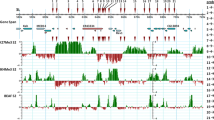Abstract
The heterochromatin of chromosome 2 of Drosophila melanogaster has been among the best characterized models for functional studies of heterochromatin owing to its abundance of genetic markers. To determine whether it might also provide a favorable system for mapping extended regions of heterochromatin, we undertook a project to molecularly map the heterochromatin of the left arm of chromosome 2 (2Lh). In this paper, we describe a strategy that used clones and sequence information available from the Drosophila Genome Project and chromosome rearrangements to construct a map of the distal most portion of 2Lh. We also describe studies that used fluorescent in situ hybridization (FISH) to examine the resolution of this technique for cytologically resolving heterochromatic sequences on mitotic chromosomes. We discuss how these mapping studies can be extended to more proximal regions of the heterochromatin to determine the structural patterns and physical dimensions of 2Lh and the relationship of structure to function.
Similar content being viewed by others
References
Adams, M.D. et al., 2000. The genome sequence of Drosophila melanogaster. Science 287: 2185-2195.
Ashburner, M. et al., 1999. An exploration of the sequence of a 2.9 Mb region of the genome of Drosophila melanogaster: the Adh region. Genetics 153: 179–219.
Butler, H., S. Levine, X. Wang, S. Bonyadi, G. Fu, P. Lasko, B. Suter & R. Doerig, 2001. Map position and expression of the genes in the 38 region of Drosophila. Genetics 158: 1597-1614.
Carvalho, A.B., B.P. Lazzaro & A.G. Clark, 2000. Y chromosomal fertility factors kl-2 and kl-3 of Drosophila melanogaster encode dynein heavy chain polypeptides. Proc. Natl. Acad. Sci. USA 97: 13239-13244.
Carvalho, A.B., B.A. Dobo, M.D. Vibranovski & A.G. Clark, 2001. Identification of five new genes on the Y chromosome of Drosophila melanogaster. Proc. Natl. Acad. Sci. USA 98: 13225-13230.
Devlin, R.H., B. Bingham & B.T. Wakimoto, 1990a. The organization and expression of the light gene, a heterochromatic gene of Drosophila melanogaster. Genetics 125: 129–140.
Devlin, R.H., D. Holm, K. Morin & B. Honda, 1990b. Identifying a single copy DNA sequence associated with the expression of a heterochromatic gene, the light locus of Drosophila melanogaster. Genome 33: 405–415.
Dimitri, P., 1991. Cytogenetic analysis of the second chromosome heterochromatin of Drosophila melanogaster. Genetics 127: 553–564.
Dimitri, P., N. Corradini, F. Rossi, F. Verni, G. Cenci, G. Belloni, I.F. Zhimulev & D.E. Koryakov, 2002. Vital genes in the heterochromatin of chromosomes 2 and 3 of Drosophila melanogaster. Genetica, this issue.
Ganetzky, B., 1977. On the components of Segregation Distortion in Drosophila melanogaster. Genetics 86: 321–355.
Hearn, M.G., 1992. The effects of chromosome rearrangements on expression and dosage of genes in 2L heterochromatin of Drosophila melanogaster. Ph.D. Thesis, Department of Genetics, University of Washington, Seattle, WA.
Hearn, M.G., A. Hedrick, T. Grigliatti & B. Wakimoto, 1991. The effect of modifiers of position effect variegation on the variegation of heterochromatic genes of Drosophila melanogaster. Genetics 128: 785–797.
Hilliker, A.J., 1976. Genetic analysis of the centromeric heterochromatin of chromosome 2 of Drosophila melanogaster: deficiency mapping of EMS-induced lethal complementation groups. Genetics 83: 765–782.
Hoskins, R.A. et al., 2000. A BAC-based physical map of the major autosomes of Drosophila melanogaster. Science 287: 2271-2274.
Howe, M., 1996. The cis-effects of heterochromatin on gene activity and polyteny in Drosophila melanogaster. Ph.D. Thesis, Department of Zoology, University of Washington, Seattle, WA.
Howe, M., P. Dimitri, M. Berloco & B.T. Wakimoto, 1995. Cis-effects of heterochromatin on heterochromatic and euchromatic gene activity in Drosophila melanogaster. Genetics 140: 1033-1045.
Le, M.H., D. Duricka & G.H. Karpen, 1995. Islands of complex DNA are widespread in Drosophila centric heterochromatin. Genetics 141: 283–303.
Leach, T.J., H.L. Chotkowski, M.G. Wotring, R.L. Dilwith & R.L. Glaser, 2000. Replication of heterochromatin and structure of polytene chromosomes. Mol. Cell. Biol. 20: 6308-6316.
Locke, J., L. Podemski, N. Aippersbach, H. Kemp & R. Hodgetts, 2000. A physical map of the polytenized region (101EF-102F) of chromosome 4 in Drosophila melanogaster. Genetics 155: 1175-1183.
Myers, E.W. et al., 2000. A whole-genome assembly of Drosophila. Science 287: 2196-2204.
Palumbo, G., M. Berloco, L. Fanti, M.P. Bozzetti, S. Massari, R. Caizzi, C. Caggese, L. Spinelli & S. Pimpinelli, 1994. Interaction systems between heterochromatin and euchromatin in Drosophila melanogaster. Genetica 94: 267–274.
Parks, S. & E. Wieschaus, 1991. The Drosophila gastrulation gene concertina encodes a Gα-like protein. Cell 64: 447–458.
Pimpinelli, S., M. Berloco, L. Fanti, P. Dimitri, S. Bonaccorsi, E. Marchetti, R. Caizzi, C. Caggese & M. Gatti, 1995. Transposable elements are stable structural components of Drosophila melanogaster heterochromatin. Proc. Natl. Acad. Sci. USA 92: 3804-3808.
Sharp, C.B., A.J. Hilliker & D.G. Holm, 1985. Further characterization of the genetic elements associated with the Segregation Distorter phenomenon in Drosophila melanogaster. Genetics 110: 671–688.
Sun, X., J. Wahlstrom & G. Karpen, 1997. Molecular structure of a functional Drosophila centromere. Cell 91: 1007-1019.
Sun, F.L., M.H. Cuaycong, C.A. Craig, L.L. Wallrath, J. Locke & S.C. Elgin, 2000. The fourth chromosome of Drosophila melanogaster: interspersed euchromatic and heterochromatic domains. Proc. Natl. Acad. Sci. USA 97: 5340-5345.
Wakimoto, B.T. & M.G. Hearn, 1990. The effects of chromosome rearrangements on the expression of heterochromatic genes in chromosome 2L of Drosophila melanogaster. Genetics 125: 141–154.
Weiler, K.S. & B.T. Wakimoto, 1995. Heterochromatin and gene expression in Drosophila. Annu. Rev. Genet. 29: 577–605.
Weiler, K.S. & B.T. Wakimoto, 1998. Chromosome rearrangements induce both variegated and reduced, uniform expression of heterochromatic genes in a development-specific manner. Genetics 149: 1451-1464.
Author information
Authors and Affiliations
Rights and permissions
About this article
Cite this article
Yasuhara, J.C., Marchetti, M., Fanti, L. et al. A Strategy for Mapping the Heterochromatin of Chromosome 2 of Drosophila Melanogaster . Genetica 117, 217–226 (2003). https://doi.org/10.1023/A:1022948229580
Issue Date:
DOI: https://doi.org/10.1023/A:1022948229580




